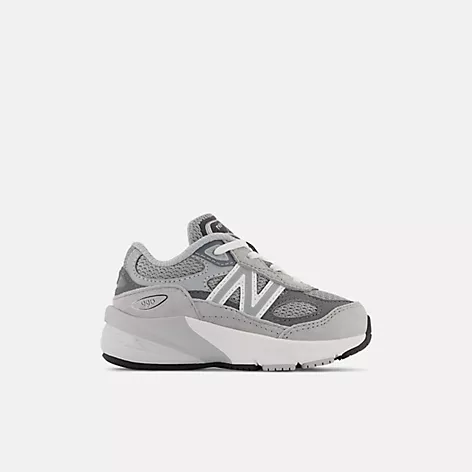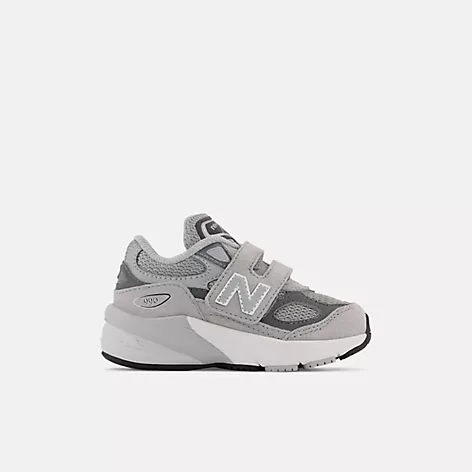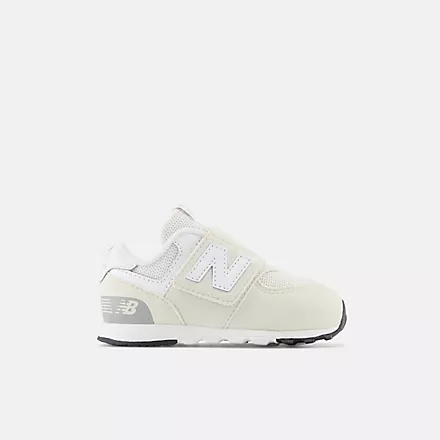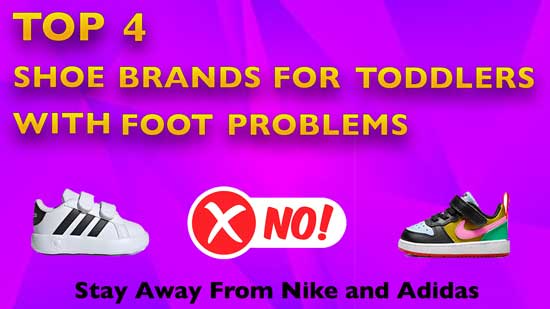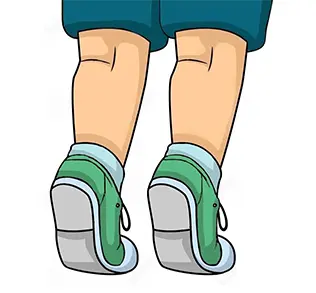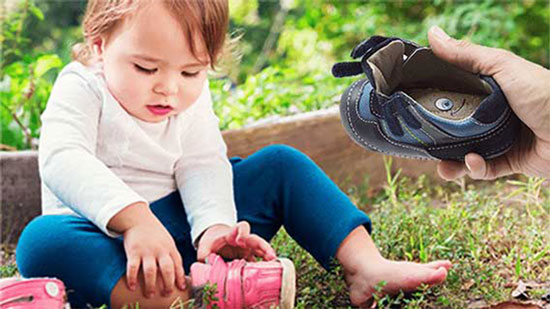My Top Shoe Recommendations for Toddlers with Foot Problems – Be Proactive!
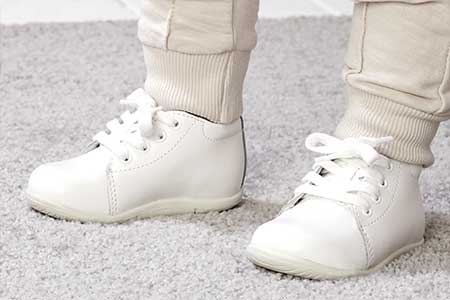
Have you noticed that your toddler keeps falling and walking with their feet turning inwards (pigeon toes)? Does your toddler keep walking on his/her toes or prefer to sit rather than play? Flat feet, pigeon toes, and toe walking are conditions relatively common in toddlers, but they need attention. Most families are told that these conditions generally resolve on their own without treatment, but the fact is that many of those toddlers continue toe walking or with poor posture habits into their teenage years. I know this because I have worked for a specialized children’s shoe store for over a decade, where we specialize in fitting shoes and orthotics for children with foot problems.
You have no idea how many families who visit the shoe store lament not having acted sooner. Early intervention can make your toddler’s foot condition a lot easier to manage.
My Experience Fitting Toddlers in Supportive Shoes and Orthotics
I have helped hundreds of toddlers with foot problems find supportive shoes for their feet. The correct types of shoes can be life-changing. Supportive shoes that fit correctly can provide stability and support, helping to guide the foot into a more natural position. This support is particularly important for children whose foot muscles and bones are still developing.
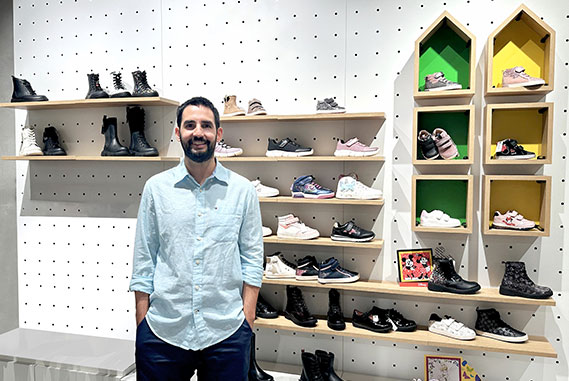
Most families who visit the shoe store tell me that their medical professionals recommended supportive footwear but don’t provide any following advice or guidance on which specific styles might be most beneficial. Some medical professionals recommend New Balance shoes for example, but they don’t specify which style numbers to get. No worries, you landed in the right place as I know exactly which toddler shoes are more supportive than others.
Now, choosing supportive shoes for your toddler is just the start. What’s equally important is taking action early. Detecting and addressing these foot conditions during the early walking stages can greatly influence your child’s development and help pave the way for a lifetime of healthier walking habits.
Most Common Foot Problems in Toddlers
The most common issues include:
1️⃣ Flat Feet
2️⃣ In-Toeing and Out-Toeing
3️⃣ Tip-Toeing
Each of these conditions, while often part of normal development (especially when it comes to flat feet), can signal the need for closer attention.
At What Age Should You Worry About Your Toddler’s Foot Condition?
It’s normal for children below the age of 4 or 5 to be flat-footed or have stability issues. However, this doesn’t mean you should leave the condition untreated. Children under the age of 5 don’t have pain, they don’t complain, but they have a treatable condition. Children over the age of 6 are not supposed to have flat feet, toe walk, or walk with their feet pointing inwards or outwards.
The Importance of Being Proactive – Don’t Play the Waiting Game
Early intervention can help prevent secondary complications such as discomfort, awkward gait patterns, or even behavioral issues stemming from the inability to participate in typical childhood activities.
Your child can avoid long-term interventions like surgery or extensive therapy if these conditions are managed well in the formative years. Ensuring your toddler wears the correct shoes is a major part of the proactive approach.
Understanding the Severity: Tailoring Footwear to the Degree of Condition
For mild to moderate conditions, a well-constructed, supportive shoe may be all that’s needed. Let’s take a look at a toddler with flat feet and a mild to moderate degree of pronation standing barefoot:
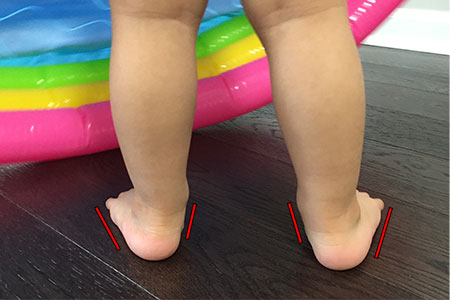
Now let’s see what happens when we fit that same toddler in a pair of the supportive shoes that I recommend:
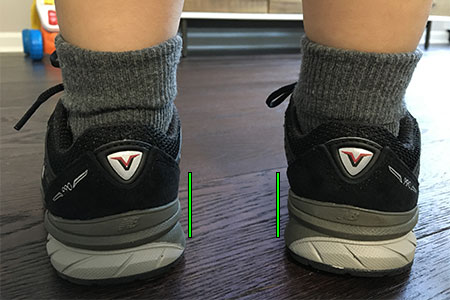
Now let’s take a look at an additional example. The toddler in the image below has a moderate degree of pronation:

Here is what happens when we fit that same child in a pair of the supportive shoes I recommend:
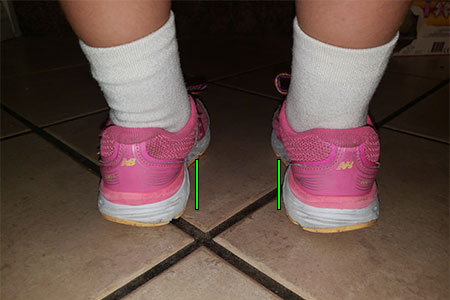
As the severity increases, so does the need for customized solutions. For significant intoeing or toe walking, a pair of orthopedic shoes or orthotics might be necessary.
What Makes the Shoes I Recommend the Best Choice for Your Toddler?
I am going to try to make things simple for you. So, these are the three key features that can do amazing things when trying to improve your toddler’s stability, foot posture, and walking gait:
1️⃣ Firm Heel Counter: This part of the shoe provides rearfoot stability and helps improve your toddler’s foot posture and walking gait. How can you check if your toddler’s shoes provide a firm heel counter? Grab your toddler’s shoes and press on the back to make sure the heel counter feels firm and sturdy:

2️⃣ Sturdy Outsole: This is the part of the shoe that provides a stable base of support and helps improve your toddler’s foot posture and stability. How can you check if your toddler’s shoes provide a sturdy outsole? Grab your toddler’s shoes and press on the middle part of the shoe and make sure it feels firm and that it doesn’t bend as shown in the image below:

3️⃣ Flexible Forefoot for Ease of Movement: This feature is crucial as your toddler’s shoes must be supportive but lightweight and flexible at the same time. How can you check if your toddler’s shoes provide the correct amount of flexibility? Your toddler’s shoes should bend at the toes but no further:
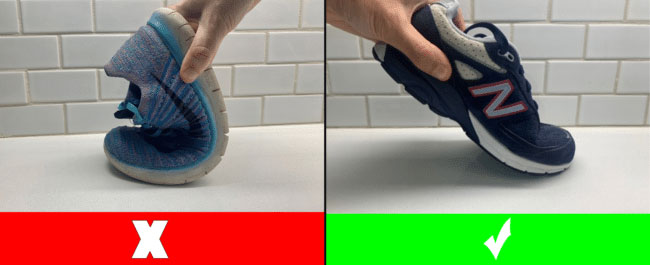
The Perfect Fit: Ensuring Comfort and Support
When it comes to addressing toddler foot conditions such as intoeing, toe walking, low muscle tone, and overpronation, finding a supportive shoe isn’t enough – it’s crucial that the shoes fit your toddler’s foot shape correctly. A perfect fit goes a long way in providing the necessary support, stability, and comfort that can help manage or even correct these conditions over time.
How to Order the Correct Shoe Size for Your Toddler
Many medical professionals get frustrated when they see toddlers wearing the correct pair of shoes but in the wrong size. It’s troubling how an ill-fitting shoe can negatively impact a toddler’s foot health. Tight footwear may hinder natural growth, while overly loose shoes can cause stumbling and inefficient gait patterns. I created a different resource for an accurate home measuring technique that will help you retrieve exactly what shoe size you should order online.
In my opinion, it’s wise to have a professional measure your child’s feet and provide recommendations. Find out if you have a specialized local children’s shoe store.
Do pay attention to consistent signs of discomfort which can indicate poor fit. Discomfort can lead to resistance, and that’s the opposite of what we’re aiming for.
Best Shoes for Toddlers with Foot Problems
Keep in mind that shoes with laces will help provide your toddler with better support and stability compared to shoes with velcro closure. Disclosure: Some links in this post may be affiliate links and we may receive a small commission (at no extra cost to you) when you click our links and make purchases.
Lace-Up Closure
- New Balance shoe style 990v6
- Fits toddlers with medium, wide, or extra wide feet
- Strong rubber outsole and cushioned midsoles
- Suede/mesh upper provides durability and breathability
- Order this shoe half a size larger than your toddler’s current foot size
- New Balance shoe style 990v6
- Fits toddlers with medium, wide, or extra wide feet
- Strong rubber outsole and cushioned midsoles
- Suede/mesh upper provides durability and breathability
- Order this shoe half a size larger than your toddler’s current foot size
- Stride Rite shoe style Emilia
- Fits toddlers with medium, wide, or extra wide feet
- Strong rubber outsole and a cushioned midsole
- 100% leather made
- Order this shoe a whole size larger than your toddler’s current foot size
- Stride RIte shoe style Elliot
- Fits toddlers with medium, wide, or extra wide feet
- 100% leather made
- Seamless construction that cradles the foot’s natural shape
- Order this shoe a whole size larger than your toddler’s current foot size
- Stride RIte shoe style Elliot
- Fits toddlers with medium, wide, or extra wide feet
- 100% leather made
- Seamless construction that cradles the foot’s natural shape
- Order this shoe a whole size larger than your toddler’s current foot size
- New Balance shoe style 990v6
- Fits toddlers with medium, wide, or extra wide feet
- Suede/mesh upper provides durability and breathability
- Order this shoe half a size larger than your toddler’s current foot size
- New Balance shoe style 2022
- Fits toddlers with medium or wide feet
- Suede/mesh upper provides durability and breathability
- Order this shoe half a size larger than your toddler’s current foot size
- New Balance shoe style 990v6
- Fits toddlers with medium, wide, or extra wide feet
- Strong rubber outsole and cushioned midsoles
- Suede/mesh upper provides durability and breathability
- Order this shoe half a size larger than your toddler’s current foot size
Velcro Closure
- Timberland Tracks H&L Boot
- Fits toddlers with medium or wide feet
- Breathable textile lining
- Stable base of support with firm heel counters
- Order this shoe a whole size larger than your toddler’s current foot size
- Saucony Cohesion
- Fits toddlers with medium or wide feet
- Heel grid system for stable cushioning
- Compression molded EVA footbed for comfort
- Order this shoe a whole size larger than your toddler’s current foot size
- New Balance style 990v6
- Fits toddlers with medium, wide, or extra wide feet
- ABZORB midsole absorbs impact through a combination of cushioning and compression resistance
- Removable insoles
- Extra deep
- Order this shoe a half size larger than your child’s current foot size
- New Balance style 574
- Fits toddlers with medium, wide, or extra wide feet
- Generous toe box and instep to accommodate and support your toddler walker’s needs
- Rubber outsole pods designed to stand up to daily wear and tear
- Extra deep
- Order this shoe a whole size larger than your toddler’s current foot size
- Memo style Gabi
- Fits toddlers with medium or wide feet
- Thermoplastic asymmetric stiff heel counter for proper feet protection and stabilization
- Stiff and high ankle support for toe walkers
- Order this shoe half a size larger than your toddler’s current foot size
- Memo style Gabi
- Fits toddlers with medium or wide feet
- Thermoplastic asymmetric stiff heel counter for proper feet protection and stabilization
- Stiff and high ankle support for toe walkers
- Order this shoe half a size larger than your toddler’s current foot size
- New Balance style 990v4
- Fits toddlers with medium or wide feet
- Generous toe box and instep to accommodate and support your toddler walker’s needs
- Extra deep
- Order this shoe a whole size larger than your toddler’s current foot size
Each child’s situation is unique, and what works for one toddler might not suit another. I am happy to send you specific shoe recommendations tailored to your toddler’s foot shape and size.
Contact Me for Shoe Recommendations Tailored to Your Toddler’s Foot Shape
Without a doubt, your toddler shoe needs can vary depending on their foot shape, walking stage, and any specific foot conditions they may have. If you have any questions or need any further assistance, you can also contact me via email and I will get back to you as soon as possible.
Learning from Experience: Testimonials and Professional Advice
I can’t emphasize enough the difference that informed decisions can make when it comes to your toddler’s foot health. Hearing from families who’ve been there can serve as an eye-opener, reinforcing the need to act sooner rather than later. Here is a list of testimonials of families I have helped throughout the years:



Don’t hesitate to seek multiple opinions if you’re unsure. Remember, each child’s situation is unique, and what works for one toddler might not suit another. I have devoted my career to understanding and treating toddler foot problems.
Proactive measures can avert long-term foot problems. When it comes to the well-being of your toddler’s feet, remember, it’s never too early to get the right help. Use these testimonials as guidance and give your toddler the supportive foundation they need for a lifetime of happy, healthy steps.


